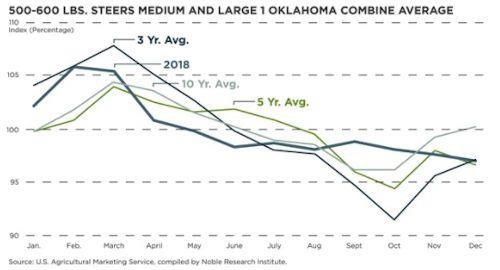By Garth Ruff
Fall is my favorite time of the year, hay making is done, the feeder cattle are being marketed, and college football is in full swing. Last winter in a cow-calf webinar, I briefly mentioned the virtues of a fall calving system here in the Eastern Corn Belt. In this article we’ll look at how fall calving can be a viable and profitable system.
Seasonality of Cattle Prices – As with most things in agriculture, supply and demand has a great impact on prices. Griffiths et al, 2017 from the University of Tennessee analyzed several studies comparing spring and fall calving systems. After comparing the systems on a 205-day weaning age and two separate feed resource scenarios they concluded that even though spring-calving cows had heavier calves at weaning and lower feed costs than the fall-calving cows, the higher prices of steer and heifer calves captured by fall-born calves were able to cover the higher feed expenses and lighter weaning weights by the fall-born calves.
In the fall of the year, when most of the weaned spring-born calves are marketed, supply is plentiful for order buyers to fill their feedlot orders. This increased supply contributes to our annual low in feeder cattle prices.
During the spring when there is demand for calves to graze wheat in the plains, and grass here locally, prices on a per cwt basis are significantly higher due to a tighter supply of calves. That tight supply of fall born calves contributes to seasonality of the markets and our annual high for stocker calves and feeder cattle.

Don’t forget that the cull markets are seasonal as well. Griffiths et al, also looking at Tennessee cull cow prices from 1990-2013 demonstrated that fall calving culls sold in April and May were valued on average $8-9 cwt higher than spring calving culls sold in September or October.
Mud –As rainfall patterns shift here in Ohio and the rest of the eastern Cornbelt, indications are that our springs are going to be warmer and wetter over time. I think we can attest to that if recent memory serves us well.
As mud becomes more of an issue, especially in the last trimester of gestation for a beef cow, research conducted at the Ohio State University has shown suggests that a cow in muddy conditions requires an additional 1.8 Mcal Net Energy/day to maintain adequate body condition, Nickles et al, 2020.
Not only does mud have an impact on cow body condition, management and feeding also become a challenge when excessive muddy conditions persist. Fall calving in September to mid-October, when soil conditions are, on average drier, can be one method to reduce the impacts of mud on cow performance.
Management Considerations – Historically, one of the biggest drawbacks to fall calving has been the increased cost to feed and maintain a lactating cow over winter. As acknowledged previously, that feed cost can be offset by higher calf values in the spring of the year.
In the past couple of years, hay quality and quantity has been a limiting factor for some cattlemen. If forage is a at a premium and cow condition is being compromised with fall calving cows why not consider reducing the caloric needs of the cow by ending lactation around 120 days of age?
In addition to improving management of available forage. We can also better manage calf performance once they are weaned. Weaned calves can be fed a grower ration until marketing later in the spring. In order to do so, there is a transfer in feed cost cost from the cow to the calf. The goal is to have calves that are healthy, “green”, and not over conditioned when turned out to graze. Whether or not higher spring calf values will offset higher calf nutrition and management costs is something to think about.
Final Thoughts – Having a defined calving season is better than none at all. What works in other parts of the country may or may not work for your herd, however it always good to evaluate various management systems and current on farm practices.
Source : osu.edu